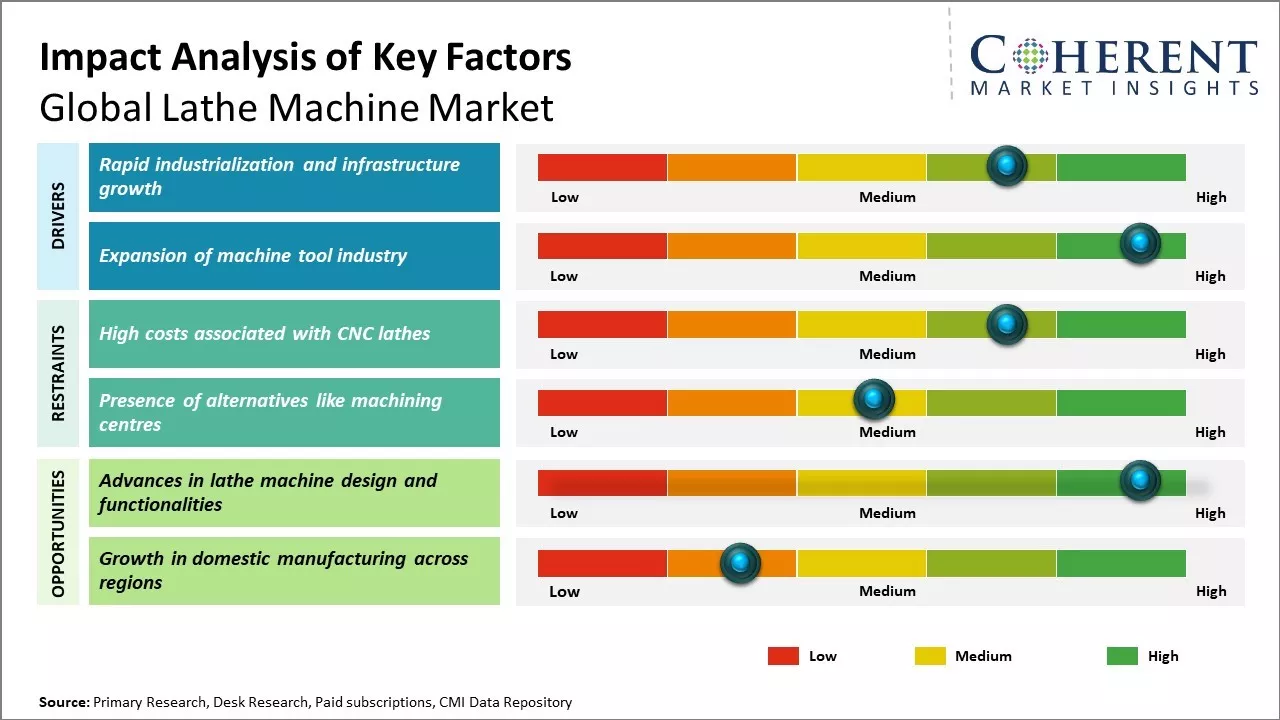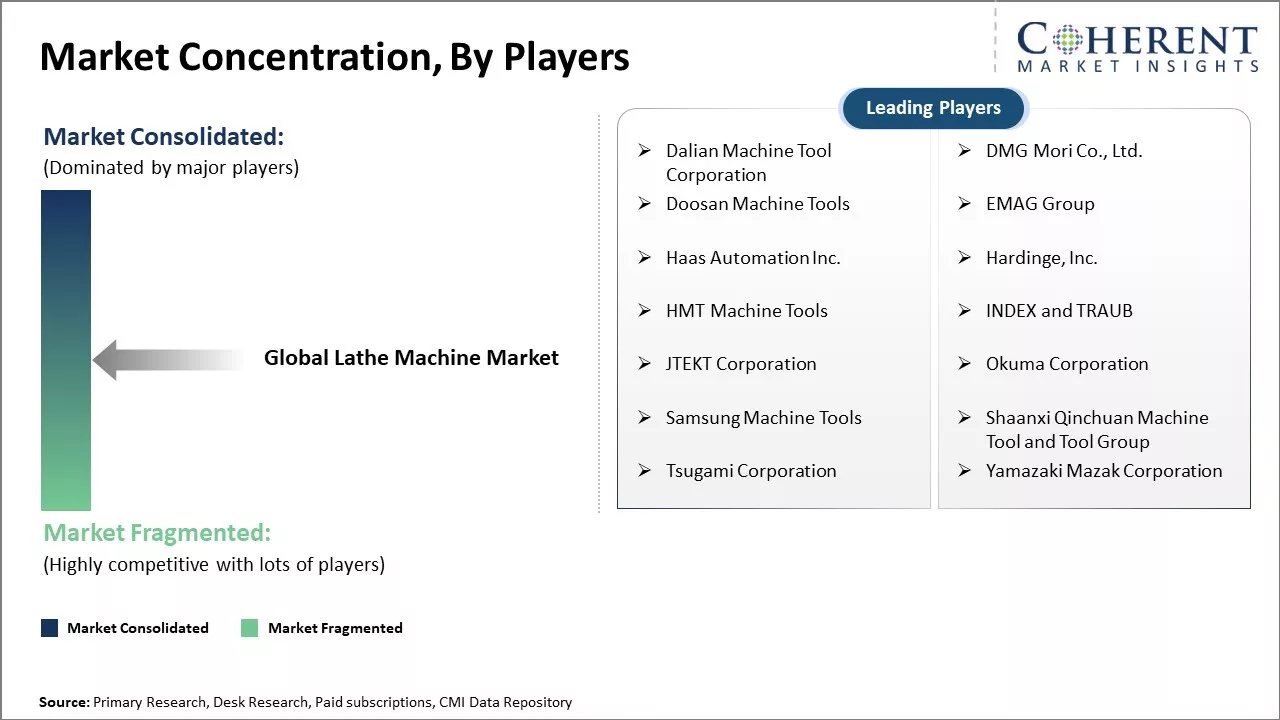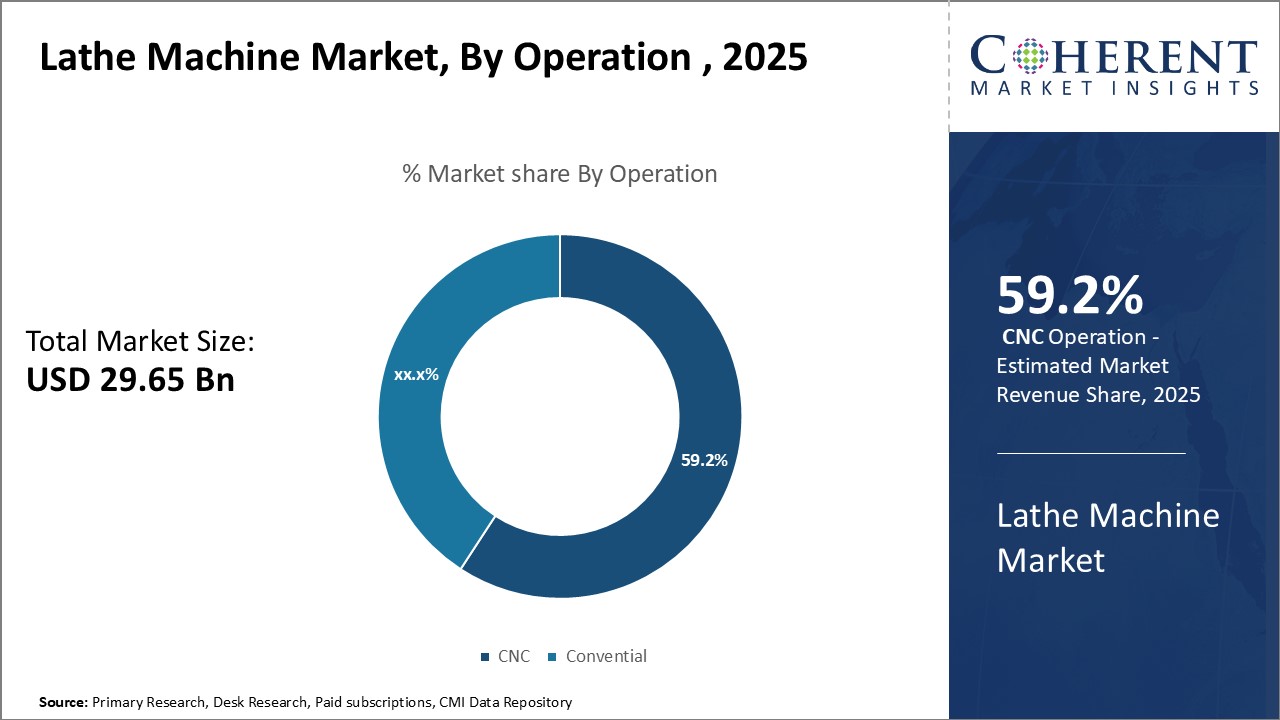Lathe Machine Market Size and Trends
The Global Lathe Machine Market is estimated to be valued at US$ 29.65 Bn in 2025 and is expected to reach US$ 42.88 Bn by 2032, exhibiting a compound annual growth rate (CAGR) of 5.4% from 2025 to 2032.

Discover market dynamics shaping the industry: Download Free Sample
Traditionally heavy industry has been the biggest end user of lathe machines. However, with developments in automotive, electronics, and other manufacturing industries, demand for Computer Numerical Control (CNC) and precise lathe machines is increasing. Automation and requirement of high precision components across all Industry verticals is expected to drive further modernization and adoption of computer numerical controlled lathe machines globally. Though market saw initial slowdown during pandemic due to disruption of supply chains and operations, demand rebounded strongly post relaxation of restrictions indicating resilient end-use demand over long term. Market players are expected to gain opportunities in developing regions and focus on aftermarket services and advanced technological features to sustain growth trajectory in the global lathe machine market.
Rapid industrialization and infrastructure growth
With the rise in industrialization and increasing infrastructure development activities all over the world, the demand for lathe machines is witnessing a significant surge. Many developing economies across Asia, Africa, and Latin America are heavily investing in boosting their manufacturing capabilities and expanding industrial bases. This is generating massive demand for various manufacturing equipment and machinery, including metalworking tools like lathe machines.
Countries want to set up new production units for automobiles, shipbuilding, electronics, aerospace, and other major manufacturing sectors. This drives the need for precise and high-accuracy lathe machines that can efficiently mass produce components and parts for these industries. Additionally, several nations are focusing heavily on improving connectivity and transportation infrastructure through new road, rail and port projects. Lathe machines play a vital role in fabricating critical metal pieces needed for building bridges, tunnels, cargo containers, railway coaches, and other infrastructure structures.
Furthermore, urbanization is rapidly increasing around the world as more people migrate to cities for better jobs and amenities. This puts tremendous pressure on governments to develop new smart cities with modern residential and commercial complexes, industrial parks, utility networks and urban transportation systems. All these construction activities generate continuous requirements for lathe machines from industries to machine large volumes of fittings, fixtures, tools and equipment required in infrastructure and building construction.
Market Concentration and Competitive Landscape

Get actionable strategies to beat competition: Download Free Sample
Expansion of machine tool industry
The global machine tool industry has experienced steady growth over the past few decades driven by rising demand from end-use manufacturing sectors. As a pivotal segment of this industry, the lathe machine market is also witnessing expansion. Major players in the machine tool market are increasingly focusing on strengthening their lathe machinery portfolio by developing automated and computer numerical control (CNC) lathes with advanced features to gain competitive advantage.
Leading lathe producers are investing heavily in Industry 4.0 technologies like Internet of Things (IoT), additive manufacturing, robotics, AI and big data to launch smart, connected lathe solutions for manufacturers. This is allowing them to enhance productivity, reduce downtime and operational costs for customers. Given the product and technology upgrades, machine tool companies are expanding their global footprint by setting up new manufacturing plants, sales and service centers worldwide. They are also enhancing overseas distribution networks and collaborating with regional distributors to boost lathe machine exports.
The growing scale and investments of the machine tool industry have increased lathe manufacturing capacities and geographical reach.
Key Takeaways from Analyst:
The market is driven by increasing manufacturing activities around the world as industries like automotive, aerospace and others are expanding rapidly. Moreover, the rising adoption of computer numerical control (CNC) lathes will further propel the demand for lathe machines.
However, high initial investment required for setting up lathe machines production units acts as a key restraining factor affecting the growth of lathe machine manufacturers. Availability of cheap labor in Asia also induces manufacturers to invest in the region. Fluctuating raw material prices introduces uncertainties in the market.
Advancements in lathe machine technology present numerous opportunities for vendors. For instance, development of multi-tasking lathes will allow various operations to be performed on a single machine, enhancing productivity. Integration of robotics enables automation of complex machining processes. Growth of metal fabrication industry especially in North America and Western Europe will drive demand for advanced lathe variants such as CNC lathes.
North America has solidified its position as the leading regional market for lathe machines. The expansion and investment within the machine tool industry have significantly enhanced lathe manufacturing capabilities and extended their geographical reach. At the same time, the Asia Pacific region has emerged as the fastest-growing market for lathe machines, with countries such as China, India, and Vietnam experiencing remarkable growth in their engineering and automotive sectors, which heavily utilize lathe machines.
Market Challenge: High costs associated with CNC lathes
The high costs involved in purchasing, installing and operating CNC lathes has emerged as a major barrier restricting the expansion of the global lathe machine market. CNC lathes enable precise machining of complex parts, however, their initial capital expenditure is substantially greater than conventional lathe machines. For example, a basic CNC lathe can cost over US$ 50,000 whereas a conventional lathe is nearly half the price. Additionally, businesses need to factor in training costs for operators, programming and software expenses which drive the total ownership costs even higher. The maintenance and repair costs of sophisticated CNC systems also add to the overall financial burden over time. These steep monetary requirements make CNC lathes unaffordable for many small machining shops and manufacturers, especially in developing economies.
Higher operational expenses of CNC lathes also discourage its adoption. Automated lathes consume more electrical power for running multiple axes and digital controllers. They also demand dedicated staff for programming, operating and upkeeping the advanced machinery. This translates to increased production costs for businesses.
Opportunity: Advances in lathe machine design and functionalities
Advances in lathe machine design and functionality present a significant opportunity for growth in the global lathe machine market. Modern CNC (Computer Numerical Control) lathes allow for far greater precision, complexity of parts produced, and automation compared to older lathe models. This has opened up new applications for lathe technology across many industries.
CNC lathes can now handle complex programming for multi-axis turning and milling-turn operations. Previously, such components may have required multiple separate machining steps on different machines. Now, advanced lathes incorporating live tooling stations and multi-tasking capabilities are reducing production time and costs for manufacturers. These multi-functional machines simplify workflows and eliminate change-over time between processes.
The automation and modular design of modern lathes also supports flexible, on-demand manufacturing practices that have become increasingly important. Companies across industries are moving toward producing low-volume, high-mix products tailored for niche markets or customized orders. Current trends indicate this shift will accelerate further.
In summary, advances in lathe technology are opening up new applications and use cases that will propel future growth in the global lathe market. The increased complexity and multi-tasking capabilities that lathes now offer help manufacturers dramatically boost production efficiencies as well. This supports trends towards customized, on-demand manufacturing worldwide.

Discover high revenue pocket segments and roadmap to it: Download Free Sample
Insights By Operation - CNC Lathe Machines Drive Market Growth
In terms of operation, the CNC segment is expected to hold 59.2% share of the global lathe machine market in 2025 owning to their precision, versatility, and automation. CNC lathe machines are computer numerical controlled, allowing manufacturers to program complex cutting paths into the machine's control unit for efficient machining of workpieces. This level of precise computer control is essential for industries like automotive that require tight tolerances and repetitive production runs. CNC lathes can switch quickly between different workpiece designs and hold close tolerances far better than conventional lathes, leading to less wasted material and rework. Their ability to run fully automated for long stretches without an operator present also boosts productivity compared to conventional lathes.
CNC lathes are readily adapted to rapidly changing production needs through easy reprogramming of the control unit. This flexibility helps manufacturers keep production lines running efficiently through design changes or new product introductions. The automation of CNC lathes also allows them to run lights-out through the night with no operator present, further increasing capacity utilization rates. While higher in initial equipment cost compared to conventional lathes, CNC lathes deliver a lower total cost of ownership through reduced labor requirements and material waste. Advancing computer and control technologies continue driving down the costs of CNC systems as well, fueling their increased uptake over conventional lathes. Growing complexity of workpiece designs, need for precision and repeatability, and pursuit of lean manufacturing practices all underpin demand for CNC lathes over more basic lathe models.
Insights By End-use Industries - Automotive Segment Demand Drives Overall Lathe Market Growth
Among end-use industries, the automotive sector segment is expected to hold 40.3% share of the global lathe machine market in 2025. Complex engine and transmission component designs require tight tolerances that can only be achieved through computer-controlled precision lathe machining. While conventional lathes still have applications, automakers rely heavily on CNC lathes for workpiece consistency demanded by just-in-time production systems. Meeting increasingly stringent emission standards also means more complex engine component profiles that push the capabilities of basic lathes.
Beyond engines and drivetrains, auto body sheet metal fabrication and other chassis components also require lathe work. Achieving optimal aerodynamic profiles and consistent assembly of these parts demand machining consistency. High volume auto production runs necessitate lathes capable of unattended operation. Robotically-loaded CNC lathes best fulfill these needs. Expansion of the global automotive industry, particularly in developing markets, leads to increased vehicle component manufacturing that bolsters lathe procurement. Usage of advanced materials like aluminum that require more precision machining versus traditional steel also stimulates lathe investments. With automotive manufacturing becoming more automated, advanced lathe technologies will continue pairing with robotics and controls for "lights-out" fabrication efficiency.
Regional Insights

Need a Different Region or Segment? Download Free Sample
North America has established itself as the dominant regional market for lathe machines. The region is estimated to account for 41.1% of the market share in 2025. With a robust manufacturing sector concentrated in countries like the U.S. and Canada, the region accounts for the largest number of metalworking companies globally. This extensive industrial base has created consistent demand for CNC and conventional lathe machines over the years.
The presence of leading machine tool manufacturers such as Hardinge, Index, and Southwestern Industries has further strengthened the regional lathe industry's supply chain. These companies have huge manufacturing plants and distribution networks within North America allowing for easy access to products. Additionally, associations like the AMT - The Association for Manufacturing Technology collaborate closely with metalworking businesses to understand market needs and help domestic manufacturers.
Meanwhile, Asia Pacific has emerged as the fastest growing regional market for lathe machines. Countries like China, India, and Vietnam have witnessed tremendous growth in their engineering and automotive industries which use lathe machines extensively. While China dominates global machine tool exports, other developing nations are also establishing domestic manufacturing bases. Their lower production costs have made Asia Pacific an attractive sourcing destination for machine tools globally.
The availability of relatively cheaper labor and raw materials in Asia Pacific provides local lathe manufacturers a competitive edge over global peers. This has helped Chinese brands such as RIFA, Dalian, and Leader gain international recognition. Rising export orders from developed markets and strong intra-regional trade have further propelled the Asia Pacific lathe industry. Governments of various nations are also introducing supportive policies and infrastructure developments to strengthen their domestic machine tool sectors.
Market Report Scope
Lathe Machine Market Report Coverage
| Report Coverage | Details | ||
|---|---|---|---|
| Base Year: | 2024 | Market Size in 2025: | USD 29.65 Bn |
| Historical Data for: | 2020 To 2024 | Forecast Period: | 2025 To 2032 |
| Forecast Period 2025 to 2032 CAGR: | 5.4% | 2032 Value Projection: | USD 42.88 Bn |
| Geographies covered: |
|
||
| Segments covered: |
|
||
| Companies covered: |
Dalian Machine Tool Corporation, DMG Mori Co., Ltd., Doosan Machine Tools, EMAG Group, Haas Automation Inc., Hardinge, Inc., HMT Machine Tools, INDEX and TRAUB, JTEKT Corporation, Okuma Corporation, Samsung Machine Tools, Shaanxi Qinchuan Machine Tool and Tool Group, Tsugami Corporation, and Yamazaki Mazak Corporation |
||
| Growth Drivers: |
|
||
| Restraints & Challenges: |
|
||
Uncover macros and micros vetted on 75+ parameters: Get instant access to report
Market Segmentation
- Operation Insights (Revenue, US$ Bn, 2020 - 2032)
- Conventional
- CNC
- End-use Industry Insights (Revenue, US$ Bn, 2020 - 2032)
- Automotive
- Industrial Machinery
- Transportation
- Others
- Regional Insights (Revenue, US$ Bn, 2020 - 2032)
- North America
- U.S.
- Canada
- Latin America
- Brazil
- Argentina
- Mexico
- Rest of Latin America
- Europe
- Germany
- U.K.
- Spain
- France
- Italy
- Russia
- Rest of Europe
- Asia Pacific
- China
- India
- Japan
- Australia
- South Korea
- ASEAN
- Rest of Asia Pacific
- Middle East & Africa
- GCC Countries
- Israel
- South Africa
- Rest of Middle East & Africa
- North America
- Key Players Insights
- Dalian Machine Tool Corporation
- DMG Mori Co., Ltd.
- Doosan Machine Tools
- EMAG Group
- Haas Automation Inc.
- Hardinge, Inc.
- HMT Machine Tools
- INDEX and TRAUB
- JTEKT Corporation
- Okuma Corporation
- Samsung Machine Tools
- Shaanxi Qinchuan Machine Tool and Tool Group
- Tsugami Corporation
- Yamazaki Mazak Corporation
Share
Share
About Author
Ramprasad Bhute is a Senior Research Consultant with over 6 years of experience in market research and business consulting. He manages consulting and market research projects centered on go-to-market strategy, opportunity analysis, competitive landscape, and market size estimation and forecasting. He also advises clients on identifying and targeting absolute opportunities to penetrate untapped markets.
Missing comfort of reading report in your local language? Find your preferred language :
Transform your Strategy with Exclusive Trending Reports :
Frequently Asked Questions
EXISTING CLIENTELE
Joining thousands of companies around the world committed to making the Excellent Business Solutions.
View All Our Clients
